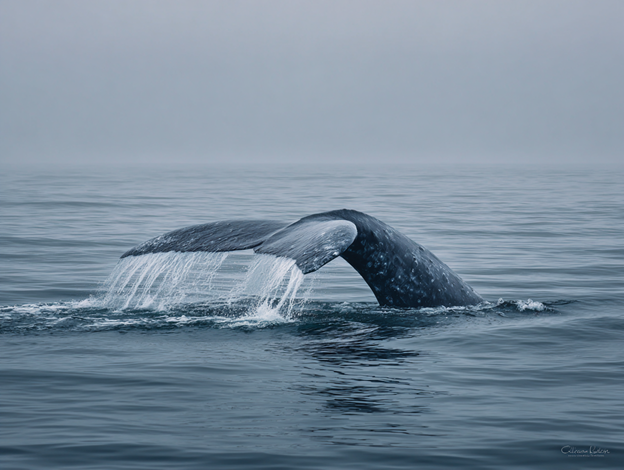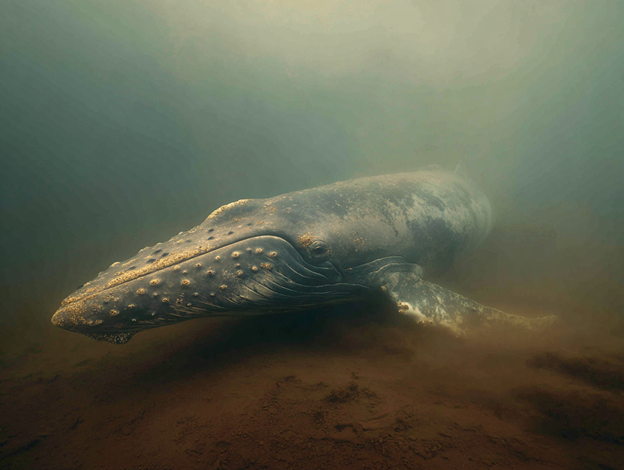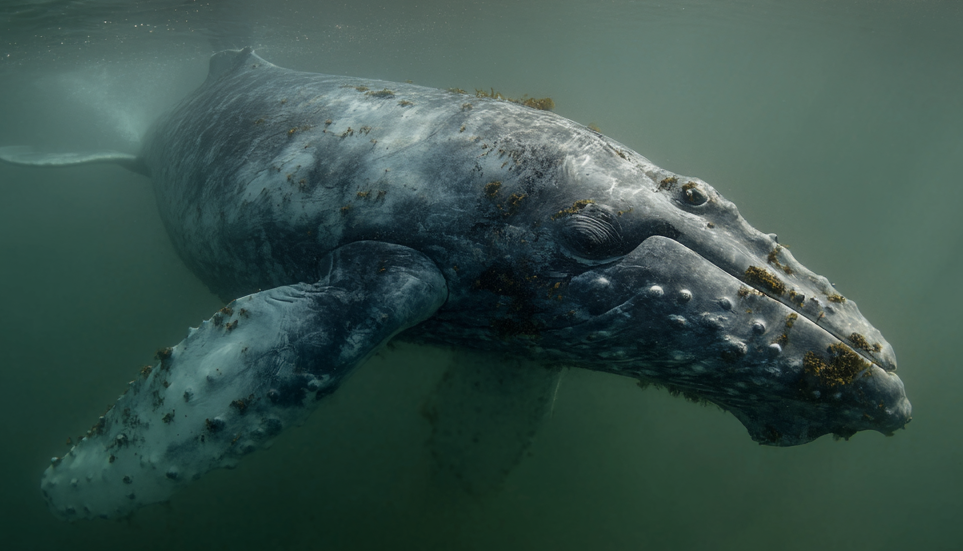Off the coast of East Asia, in the waters surrounding Sakhalin Island and the Korean Peninsula, lives a population of whales that, according to science, should not exist. The Western Gray Whale, a distinct population of Eschrichtius robustus, was hunted so relentlessly in the 19th and 20th centuries that by the 1970s, it was declared effectively extinct. Its disappearance was a closed chapter. But then, a ghost appeared. A tiny, remnant group of whales was rediscovered, clinging to survival in a region steeped in ancient myths of sea dragons and powerful ocean spirits. The story of the Western Gray Whale is a modern miracle—a narrative of death and resurrection that challenges our definitions of extinction and connects the deep, cultural reverence for ocean dragons to the fragile reality of a population brought back from the dead.
I. Biological Snapshot: A Scientific Profile
- Scientific Name / Genus / Population: Eschrichtius robustus, Western Subpopulation (also known as the Western North Pacific population)
- Recognized Population & IUCN Status:
- Population: Western Gray Whale
- IUCN Status: Critically Endangered. This is one of the smallest and most threatened large whale populations in the world.
- Physical Characteristics:
- Length: 12 to 15 meters (40 to 50 ft).
- Weight: 30 to 40 tons (60,000 to 80,000 lbs).
- Lifespan: 50 to 70 years.
- Distinguishing Features: Identical in appearance to the Eastern Gray Whale, with mottled gray skin covered in barnacles and whale lice. They are bottom-feeders, often surfacing with mud on their heads. They lack a dorsal fin, instead having a series of low "knuckles" on their lower back.
- Distribution & Habitat: Their primary and only known feeding ground is off the northeastern coast of Sakhalin Island, Russia, in the Sea of Okhotsk. Their migration route and winter calving grounds are poorly understood, but are thought to be in the South China Sea, likely off the coast of southern China.
- Diet & Foraging: Specialized bottom-feeders (benthic), consuming small crustaceans, primarily amphipods and isopods, by sucking up sediment from the seafloor and filtering out the prey.
- Reproduction:
- Gestation Period: 12 to 13 months.
- Calf Size at Birth: ~4.5 meters (15 ft) long.
- Sexual Maturity: 5 to 12 years.
- Calving Interval: A single calf is born every 2 to 3 years.

II. Ancient Myths: The Dragons of the Sea
In the traditional cosmologies of Korea and Japan, the seas were inhabited by powerful, serpentine dragons (yong in Korean, ryū in Japanese). These were not the fire-breathing dragons of European myth, but benevolent and powerful water spirits, the rulers of the oceans, rivers, and rains. They were often depicted as long, sinuous beings who moved with grace and power through the water, their backs breaking the surface in a series of undulating humps.
For ancient coastal peoples, the sight of a large gray whale migrating close to shore—its long back and series of dorsal knuckles breaking the surface in succession—could easily have been interpreted as the physical manifestation of such a sea dragon. The whale's mysterious appearance from the depths and its powerful, serpentine movement would have resonated deeply with these ancient dragon myths, solidifying its status as a creature of immense spiritual power, a ruler of the watery realm.

III. A Modern Miracle: The Rediscovered Whale
The industrial whaling of the 19th and 20th centuries had no reverence for dragons. Korean and Japanese whaling operations, later joined by Russian fleets, targeted the Western Gray Whale with devastating efficiency. By the mid-20th century, the hunt was over because there were simply no whales left to find. The population was considered extinct, a tragic loss memorialized in scientific literature.
Then, the miracle happened. In the 1980s and 1990s, scientists conducting surveys off Russia's Sakhalin Island began to have sporadic sightings of gray whales. At first, they were thought to be strays from the healthy Eastern Pacific population. But genetic analysis confirmed the impossible: they were the direct descendants of the "extinct" Western population. A tiny, remnant group had somehow survived, hidden in the remote feeding grounds of the Sea of Okhotsk.
This rediscovery created a powerful new narrative for the whale: the Lazarus species, the population that came back from the dead. It is a story of incredible resilience, a testament to the power of life to endure even in the face of overwhelming destruction. The dragon had not been slain; it had simply been in hiding.

IV. The Struggle of the Returned Dragon
The rediscovery of the Western Gray Whale was a moment of hope, but the population remains on a knife's edge. Its survival is threatened by the intense industrialization of its only known feeding ground.
- Oil and Gas Development: The primary threat to the Western Gray Whale is the massive offshore oil and gas development projects located directly on their feeding grounds off Sakhalin Island. These operations create a host of dangers:
- Underwater Noise: Seismic surveys, drilling, and vessel traffic create a constant barrage of noise that can disrupt feeding, mask communication, and cause chronic stress.
- Habitat Degradation: The construction of pipelines and other infrastructure can physically destroy their benthic feeding habitats.
- Ship Strikes: Increased vessel traffic in the area raises the risk of fatal collisions.
- Oil Spills: A major oil spill in this critical habitat would be catastrophic for the entire population.
- Entanglement in Fishing Gear: The whales are also at risk from entanglement in fishing gear, particularly on their unknown migration route and in their winter breeding grounds.
Conservation efforts, led by the IUCN and a panel of independent scientists, have focused on working with the oil and gas companies to mitigate their impact. This has included rerouting pipelines, restricting seismic surveys during the feeding season, and funding long-term monitoring of the whales.
The Western Gray Whale is a threshold guardian that carries a unique message. It is a story of hope, proving that even populations we believe are lost can return. But it is also a story of extreme fragility. The fate of this entire, ancient lineage now depends on its ability to coexist with massive industrial operations in its only known kitchen. The dragon has returned from the sea, only to find its lair surrounded by the machinery of the modern world. Its survival will depend on whether we choose to honor its miraculous resurrection or finish the job we started a century ago.
🔷 The North Direction Teaching 🔷
The Western Gray Whale embodies the North's wisdom of impossible return—from declared extinction to fragile hope. With only 200 dragons left, it teaches us that resurrection is real, but survival requires our humility. The North asks: If a species can return from death itself, can we find the wisdom to protect its miraculous second chance? Will we let the dragon live, or destroy it again?
References & Further Reading
- NOAA Fisheries - Gray Whale Species Profile and Conservation Status
- Marine Mammal Commission - Western North Pacific Gray Whales (Comprehensive Overview)
- International Whaling Commission - Gray Whale Natural History and Conservation
- IUCN Cetacean Specialist Group - Western Gray Whale News and Research
- IUCN - Ship Strike Risk Study for Gray Whales in North Pacific (2021)
- IUCN - Landmark Conservation Cooperation for Western Gray Whales
- Federal Register - 2024 Update to Western Gray Whale DPS Description
- Wikipedia - Gray Whale (Comprehensive Natural History and Population Status)